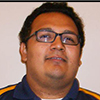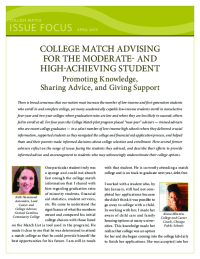College Match Advising for the Moderate- and High-Achieving Student
Promoting Knowledge, Sharing Advice, and Giving Support

There is broad consensus that our nation must increase the number of low-income and first-generation students who enroll in and complete college, yet many academically capable low-income students enroll in nonselective four-year and two-year colleges where graduation rates are low and where they are less likely to succeed; others fail to enroll at all. For four years the College Match pilot program placed “near-peer” advisers — trained advisers who are recent college graduates — in a select number of low-income high schools where they delivered crucial information, supported students as they navigated the college and financial aid application process, and helped them and their parents make informed decisions about college selection and enrollment. Here several former advisers reflect on the range of issues facing the students they advised, and describe their efforts to provide informed advice and encouragement to students who may unknowingly underestimate their college options.

Kelli Hammond Antonides, Lead Career and College Advisor, Central Carolina Community College
One particular student truly was a sponge and could not absorb fast enough the college match information that I shared with him regarding graduation rates of minority students, financial aid statistics, student services, etc. He came to understand the significance of what the numbers meant and compared his initial college choices with those listed on the Match List [a tool used in the program]. He made it clear to me that he was determined to attend a match college so that he could provide himself the best opportunities for his future. I am still in touch with that student. He is currently attending a match college and is on track to graduate next year, debt-free.

Alana Mbanza, College and Career Coach, Chicago Public Schools
I worked with a student who, by late January, still had not completed her applications because she didn’t think it was possible to go away to college with a child. In working with her, I made her aware of child care and family housing options at many universities. This knowledge made her realize that college was an option for her and she began coming into the college lab daily to finish her applications. She was accepted into her top choice and received enough grant and scholarship money to cover her entire cost of attendance with no student loan debt.

Ebelio Mondragon, Admissions Advisor, University of California at Berkeley
One of my students had not even thought of applying to the University of Illinois at Urbana-Champaign [UIUC, the state’s flagship university]. I saw his potential and highly encouraged him to apply. After some convincing he agreed. I worked with him during his lunch hour and a few weekends to ensure his application was competitive and his personal statement was strong. I constantly challenged him to dig deeper with his personal statement and show his strengths through examples. Upon receiving his letter of acceptance, he worked with me to get an understanding of his financial aid, and I helped him weigh his options. Ultimately he decided to matriculate to UIUC once he saw all of the opportunities available.

Jessica Salazar, Post-Secondary Specialist, Chicago Public Schools
When I initially started working with students, there was one student who had just transferred to the school. As a new student he had not created a relationship with anyone in the building; I made it my goal to make sure he knew who I was and that I was there to help him. When he didn’t come to see me, I would wait for him outside of his classes. He quickly understood that he would not get rid of me very easily. I started to see him on a daily basis. After submitting several scholarship applications, he was awarded some. With the scholarship money he was able to pay to attend his top college choice.

Mariana Saucedo, College and Career Coach, Chicago Public Schools
The majority of the students I met with were also first-generation college students. Their parents trusted them to make the big decisions and in some cases I was the only one helping the students with their applications. I became a trusted resource for students, showing them a variety of college options they hadn’t previously considered. Some of my specific contributions included helping students research other aspects like retention and graduation rates and thinking about their potential long-term successes on different college campuses.






